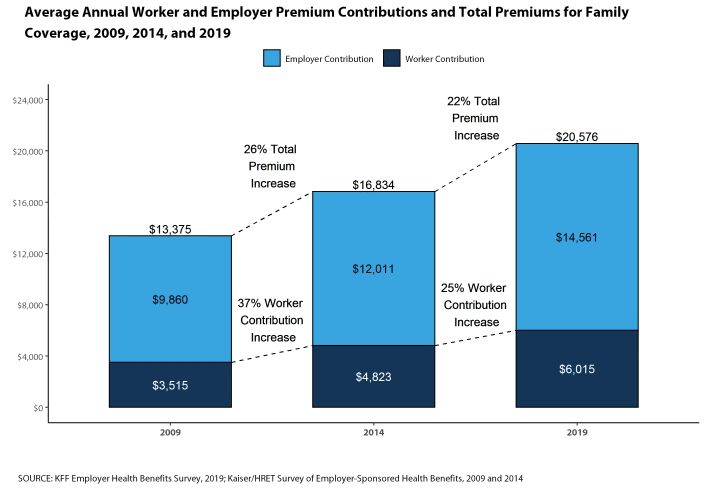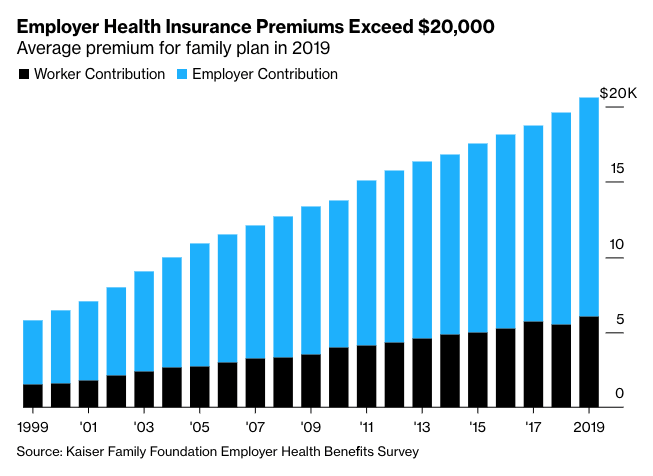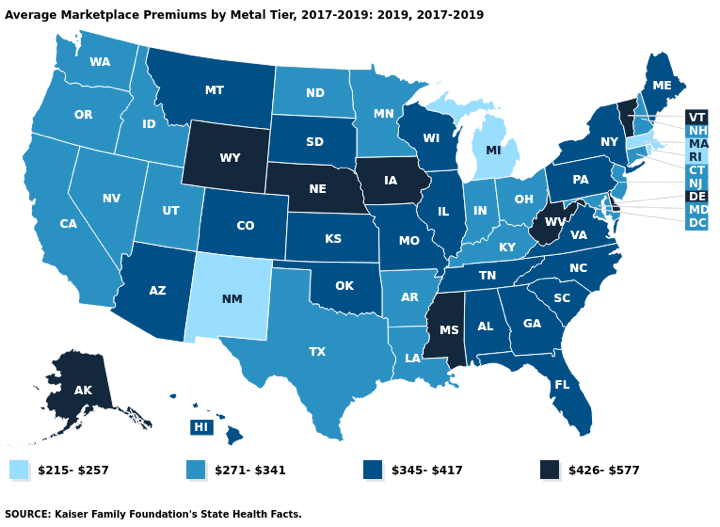
When the topic of early retirement comes up, a common question is “Are you concerned about health insurance?” I could be a cheerleader and say “nah no big deal”, but to be honest it has impacted my early retirement plans. Not only are the costs high today, but imagine how much higher they will get in the future if current trends continue.
The Kaiser Family Foundation (KFF) released the results of their annual , and the cost of family health coverage in the U.S. now tops $20,000 a year. This is more than a 50% jump from just 10 years ago:

Here’s another chart (same data set) from this that goes farther back.

If you are single or a couple without kids, here’s a of the average monthly premium for the lowest Silver plan (per person):

The premium prices listed above don’t include deductibles and out-of-pocket expenses, which are rising as well and add up to another $2,000 per year on average:
Deductibles are rising even faster than premiums, meaning that patients are on the hook for more of their medical costs upfront. For a single person, the average deductible in 2019 was $1,396, up from $533 in 2009. A typical household with employer health coverage spends about $800 a year in out-of-pocket costs, not counting premiums, according to research from the Commonwealth Fund. At the high end of the range, those costs can top $5,000 a year.
Obviously, budgeting another $15,000 to $20,000+ in healthcare costs is going to be a huge factor to consider. Here are the ways that I have seen folks deal with this cost.
- Use an Affordable Care Act (ACA) plan and get a subsidy if your income (MAGI) is low enough to qualify. KFF has a very handy that will help you estimate this. If you live in California, The Finance Buff has some helpful information on the . The annoying part is you never know if the rules will change on you down the road.
- Plan ahead with a job that offers health insurance benefits after you retire and before Medicare kicks in. You’ll probably have to hunker down with the same employer for a number of years.
- Save enough money (or create enough income) to pay for health insurance premiums.
- Find a part-time job that you both enjoy and offers health benefits. Employers know that health insurance is expensive, but you can negotiate benefits as part of your total compensation.
- Run a part-time side business that earns enough profit to cover health insurance costs. Look for potential group discounts or tax breaks that are available as a business instead of a consumer.
- If it works for your situation, try a high-deductible health plan (HDHP) and fund a Health Savings Account (HSA) due to the tax advantages.
- Join a or that is exempt from ACA.
- Extend your current employer coverage for up to 18 months through COBRA (check cost).
- Move to a foreign country with reasonable and transparent cash pricing.
- Some people have bought short-term health insurance plans, but these are not ACA-compliant “full insurance”. Beware the limitations. Read the .
- Here’s a person who to qualify for Medicaid.
Right now, we are covered by employer-sponsored health insurance, but for us it is a negotiated part of the total compensation. You can’t expect an employer to keep your same benefits package when you work less than full-time, but you can agree to take less salary in exchange for health insurance. At other times, we have bought health insurance directly. The most recent cost was around $1,600 a month for our family, very close to that $20,000 number. Even if we could qualify for a partial ACA subsidy, we would still be looking at around $10,000 a year in healthcare costs.
The difference with healthcare costs is that once you qualify for Medicare, your costs should hopefully be much less than that $20,000 a year price tag. According to , the national average cost for Medigap Plan F is $1,712 annually, or just under $150 a month.
So the amount you have to save to retire early depends on how many years you have until age 65. For us, that’s 25 years so that’s a big number and I don’t see how that doesn’t extend the time you need to be ready for retirement. Health insurance was definitely a factor in us going the more gradual semi-retired route.
Now imagine the overall impact that healthcare costs have on businesses, both big and small. Services and products cost more to make when every employee costs more to insure. I was able to take risks as an entrepreneur because my spouse had health insurance that covered both of us. If I had to keep my family covered with health insurance, I might still be working at MegaCorp. As , “medical costs are the tapeworm of American economic competitiveness”. In the coming years, I wonder how both the healthcare and student loan situations will change, because the current trajectories are unsustainable.
“The editorial content here is not provided by any of the companies mentioned, and has not been reviewed, approved or otherwise endorsed by any of these entities. Opinions expressed here are the author’s alone. This email may contain links through which we are compensated when you click on or are approved for offers.”
from .
Copyright © 2019 MyMoneyBlog.com. All Rights Reserved. Do not re-syndicate without permission.